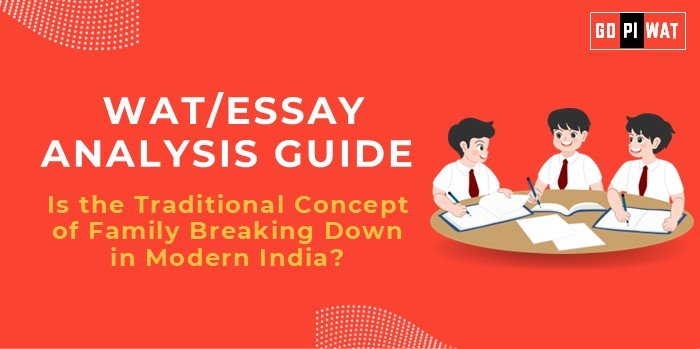📋 Is the Traditional Concept of Family Breaking Down in Modern India?
🌐 Understanding the Topic’s Importance
The traditional family structure in India is often idealized as the foundation of social and moral values. However, in today’s socio-economic landscape, the flexibility of family forms is more common, sparking debate about whether this signifies a breakdown or an adaptation in response to modern demands.
📝 Effective Planning and Writing
- ⏱️ Time Allocation:
- Planning: 5 minutes
- Writing: 20 minutes
- Review: 5 minutes
- 📚 Preparation Tips:
- Collect key statistics on urbanization, family types, and economic changes.
- Note examples of shifting family dynamics in India.
💡 Introduction Techniques for Essays
- ✍️ Contrast Approach: “Despite India’s rich heritage of joint families, the rise of nuclear families reflects shifts in economic and social priorities, posing questions about the sustainability of traditional family structures.”
- 💡 Solution-Based Introduction: “As Indian families face pressures from urbanization and job markets, balancing tradition with modernity may hold the key to sustaining family values.”
- 📖 Timeline Approach: “Once the backbone of Indian social life, the traditional family has seen significant change over the past few decades, largely due to urban migration and economic liberalization.”
📖 Structuring the Essay Body
- 🏆 Achievements:
- Economic stability from dual-income nuclear families.
- Increased autonomy for younger generations, particularly women.
- ⚠️ Challenges with Comparative Analysis:
- Issues such as the need for elder support and the potential isolation of family units.
- Examples from countries like Japan, which face similar challenges due to an aging population.
- 🔮 Future Outlook:
- Explore outcomes such as the rise of elder-care services and adjustments in social security policies to support evolving family structures.
🎯 Concluding Effectively
- ⚖️ Balanced Conclusion: “The traditional Indian family structure faces pressures to adapt to economic and social changes. By finding a balance between tradition and modern demands, families can preserve core values while remaining relevant.”
- 🌍 Global Comparison Conclusion: “India’s family dynamics are evolving much like other societies worldwide. Learning from global experiences can help manage challenges without losing the unique essence of Indian family values.”
📊 Analyzing Successes and Shortcomings
- ✅ Achievements: Growth of nuclear families with financial independence and enhanced autonomy for women.
- ⚠️ Ongoing Challenges: Ensuring elder care, balancing work and family life, managing urban isolation.
- 🌍 Global Context: Other countries like South Korea and Japan face similar changes in family structure, especially regarding elder care and work-life balance.
🔧 Recommendations for Sustainable Progress
- 📜 Policy Support: Encourage government-backed elder care services.
- 🏢 Corporate Initiatives: Promote family-friendly workplace policies that support work-life balance.
- 🤝 Community Solutions: Strengthen community support networks to bridge generational gaps and address isolation.
✍️ Sample Short Essays on the Topic
- ⚖️ Balanced Perspective: “India’s family structure is not disintegrating but rather evolving to meet modern demands. With economic changes and urbanization, families are restructuring, often strengthening personal independence and financial stability.”
- 💡 Solution-Oriented: “As Indian families adapt, targeted policies supporting elder care and family-friendly work environments can help bridge the gap between traditional and nuclear family structures.”
- 🌍 Global Comparison: “India’s shift in family structure mirrors global trends in many industrialized countries, where economic shifts and changing social norms lead to flexible, diverse family models.”


